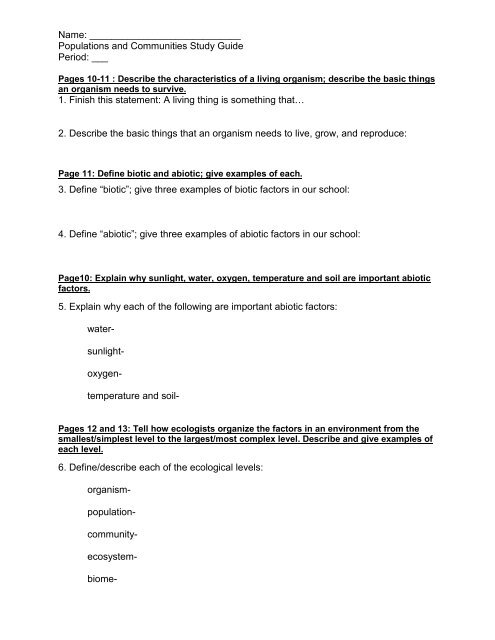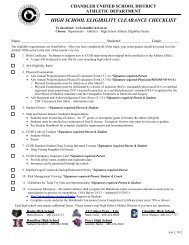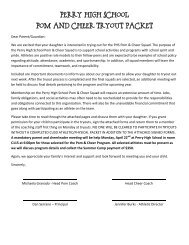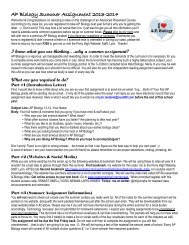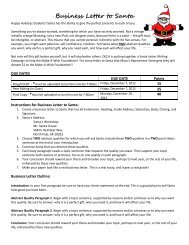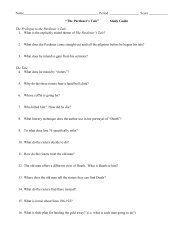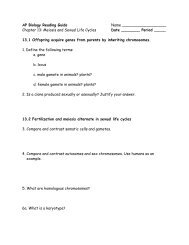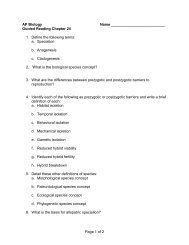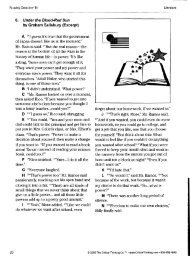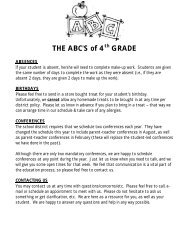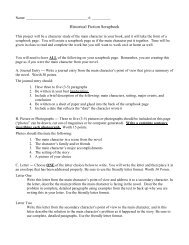Populations and Communities Study Guide Period: ___ 1. Finish this ...
Populations and Communities Study Guide Period: ___ 1. Finish this ...
Populations and Communities Study Guide Period: ___ 1. Finish this ...
You also want an ePaper? Increase the reach of your titles
YUMPU automatically turns print PDFs into web optimized ePapers that Google loves.
Name: ____________________________<br />
<strong>Populations</strong> <strong>and</strong> <strong>Communities</strong> <strong>Study</strong> <strong>Guide</strong><br />
<strong>Period</strong>: ___<br />
Pages 10-11 : Describe the characteristics of a living organism; describe the basic things<br />
an organism needs to survive.<br />
<strong>1.</strong> <strong>Finish</strong> <strong>this</strong> statement: A living thing is something that<br />
2. Describe the basic things that an organism needs to live, grow, <strong>and</strong> reproduce:<br />
Page 11: Define biotic <strong>and</strong> abiotic; give examples of each.<br />
3. Define “biotic”; give three examples of biotic factors in our school:<br />
4. Define “abiotic”; give three examples of abiotic factors in our school:<br />
Page10: Explain why sunlight, water, oxygen, temperature <strong>and</strong> soil are important abiotic<br />
factors.<br />
5. Explain why each of the following are important abiotic factors:<br />
water-<br />
sunlight-<br />
oxygen-<br />
temperature <strong>and</strong> soil-<br />
Pages 12 <strong>and</strong> 13: Tell how ecologists organize the factors in an environment from the<br />
smallest/simplest level to the largest/most complex level. Describe <strong>and</strong> give examples of<br />
each level.<br />
6. Define/describe each of the ecological levels:<br />
organism-<br />
population-<br />
community-<br />
ecosystem-<br />
biome-
7. Complete the table below by filling in the blank sections with information that would<br />
be true for a study about coyotes in an urban/desert biome.<br />
Complex Simple<br />
_____________________<br />
Population<br />
____________________<br />
Ecosystem<br />
____________________<br />
Ecological Organization: Coyote<br />
One Coyote<br />
____________________<br />
(List three examples)<br />
____________________<br />
____________________<br />
____________________<br />
All of the above, plus (list 3 examples)<br />
__________________<br />
__________________<br />
__________________<br />
All desert/urban ecosystems found<br />
around the world.<br />
Page 15: Identify the four methods that scientists use to determine the size of a<br />
population. Explain the advantages <strong>and</strong> disadvantages of each method.<br />
8. Explain the advantages <strong>and</strong> disadvantages of each method used by ecologists to find<br />
the size of a population in the wild:<br />
Method Description of Method Advantage Disadvantage<br />
Direct observation<br />
Indirect observation<br />
Sampling<br />
Mark-<strong>and</strong>-Recapture<br />
Page 15 : Explain how food, water, weather, <strong>and</strong> shelter act as limiting factors for a<br />
population.<br />
9. Define each of the following terms:<br />
limiting factor-<br />
carrying capacity-<br />
immigration/emigration-<br />
10. Why are food, water, weather, <strong>and</strong> shelter important limiting factors


